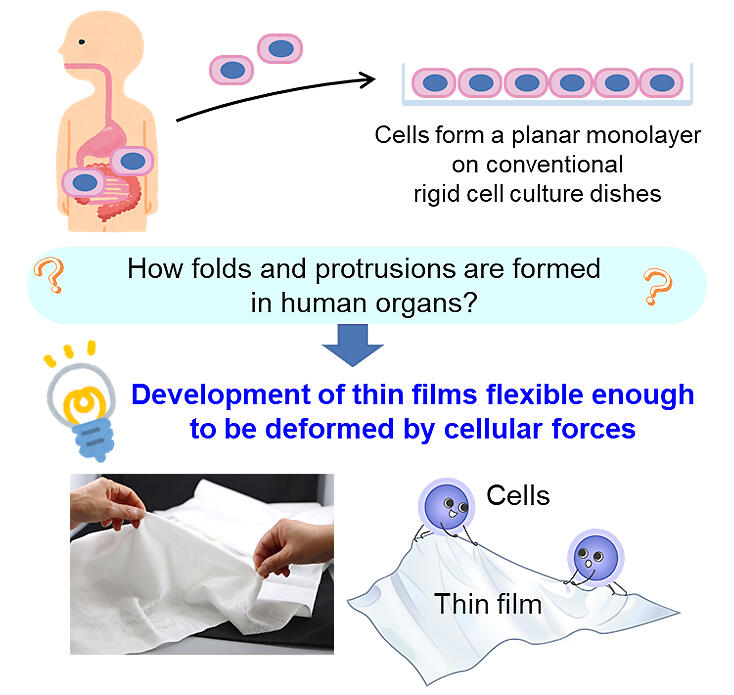Principal Researchers Tomoko G. Oyama and Kotaro Oyama and Project Leader Mitsumasa Taguchi from Takasaki Advanced Radiation Research Institute, QST Quantum Beam Science Research Directorate along with Associate Professor Hiromi Miyoshi from Tokyo Metropolitan University used ion beam processing technology to develop a thin flexible cell culture film that buckles even in response to a very weak applied force, pulling the adhesive surface. They also succeeded in creating a three-dimensional (3D) cellular sheet with folds and protruding structures that increase adhesiveness, thereby allowing cells to grip the surface. Adjusting the thin film thickness and pattern allows the cells to be peeled off the thin film substrate and undergo 3D deformation. Their research has been published in Materials & Design.
Three-dimensional structures, such as folds and protrusions, formed in vivo are best suited for enabling the specialized cells in tissues and organs to perform their respective functions. One question that remained to be answered was "How do cells form these 3D structures?"
When somatic cells are cultured and studied in conventional hard plastic dishes, the cells can spread only in one plane and are unable to form 3D structures. Cells are known to exert traction forces on adhesive surfaces, although these forces are very weak. Focusing on cell-mediated traction forces, this research group decided to enable cells to do the same 'wrinkle effect' as observed when grabbing a soft cloth.
To accomplish this aim, the research group developed a flexible thin film for cell culture that can be deformed by the very weak forces generated by cells. They aimed to make cells adhere to the thin film and induce the formation of folds and protrusions. By precisely controlling the type and location of the chemical reaction initiated by the ion beam, they created a biocompatible and biodegradable polylactic acid-layered surface, which would peel off in the form of a thin film in response to the very weak force produced by the cells cultured on it. This film consists of a surface layer with enhanced adhesiveness that allows cells to exert traction effectively, a lower layer that dissolves in the culture medium during cell culture, and a substrate to which the surface layer and lower layer can adhere.
When the surface layer thickness was adjusted to allow deformation by forces generated by cells during culture, individual cells were observed to pull the surface layer, generating wrinkles as they migrated. Furthermore, the surface layer was patterned (by introducing cut lines) so that the thin film could be easily peeled off by cellular activity. As a result, the cultured cells were observed to peel off the thin film, starting from the edge of the pattern (i.e., from the cut line), thereby leading to 3D deformation of the film. By adjusting the shape and size of the pattern using cut lines, they succeeded in creating a 3D cellular sheet with huge folds and protrusions that can be seen with the naked eye in just a few days.

Credit: National Institutes for Quantum Science and Technology (QST)
The force exerted by a single cell is very weak, but in a soft body, cells may cooperate with each other to independently shape their surrounding environment into 3D structures. A flexible, cell culture compatible thin film that can form a 3D cellular sheet utilizing the very small forces generated by cells is considered to be an important tool for clarifying the original morphologies and functions of cells. Not only does this novel 3D cellular sheet provide a tool to solve the mysteries of complex structure formation in living organisms, it is also expected to contribute to the development of new therapeutic technologies, such as transplantable cellular sheets that can fit to uneven surfaces such as the stomach and intestines.
This article has been translated by JST with permission from The Science News Ltd.(https://sci-news.co.jp/). Unauthorized reproduction of the article and photographs is prohibited.




